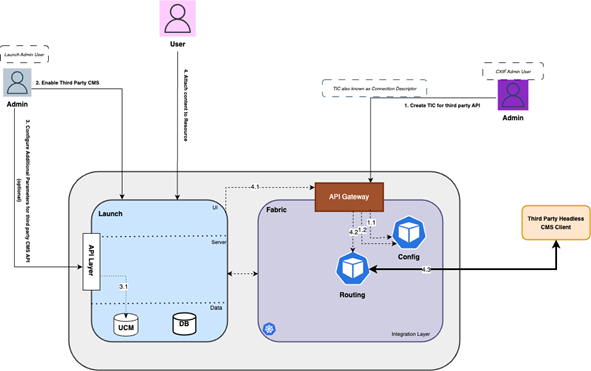3 Launch Cloud Service Third Party Content Management System Integration
The Integration between Launch and a Headless third party Content Management System (CMS) is required to manage content across your ecosystem.
Introduction
This comprehensive guide provides step-by-step instructions for implementing a third-party Headless Content Management System (CMS) integration with Launch. The integration allows for efficient content management and retrieval, enhancing the overall functionality of the Launch platform. The document is compiled with the assumption that there is a concrete implementation of the third party CMS Swagger provided by Launch.
Purpose
The purpose of this integration is to enable Launch to interact with external CMS systems, providing flexibility in content management and allowing for seamless content retrieval and display within Launch.
Scope
This chapter covers the entire process from initial configuration in Fabric to final testing in Launch, including API setup, authentication configuration, and Launch-specific settings.
Prerequisites
- Access to the CXIFHost environment (e.g., https://your-cxif-host-example.com)
- Access to the FAHost environment (e.g., https://fa-host-example.com)
- Tenant Admin privileges for running /admin APIs
- Visual Builder Studio access with appropriate permissions
- Authentication credentials for the third-party CMS (OAuth2, Basic Auth, or OCIHttpSignature)
- Familiarity with RESTful APIs and JSON
- Access to curl or Postman for API testing
- Understanding of CORS (Cross-Origin Resource Sharing) concepts
- Knowledge of the specific third-party CMS being integrated
Related Guides
Table 3-1 Related Guides for Third Party Content Management System Integration
| Reference | Description |
|---|---|
| Implement CX Industries Framework | Describes the setup and implementation of the CX Industries Framework required to deploy Launch Cloud Service. |
System Architecture Overview
- Fabric: Acts as the API management and routing layer.
- Launch: The application platform that will consume CMS content.
- Third-party CMS Client: The external content management system.
The flow of data is as follows:
Launch > Fabric > Third party CMS
- Assuming the CMS Client is ready, the process begins with creating a TIC or Connection Descriptor and updating the Gatekeeping Rules using the Admin API. This TIC specifies authentication method, credentials, and host information of the CMS client.
- Launch must be configured to recognize the third-party CMS, this configuration is done via Visual Builder Studio.
- If the CMS client needs additional parameters with each request, these are set up as a JSON configuration in Launch UCM at this path: attachment/thirdPartyCMSParamters/AdditionalParams.json.
- Once configured, users can interact with the system. When editing a resource like Product Offering, clicking Add Images or Add Documents triggers a network call to the third-party CMS client using Fabric.
Finally, Launch renders the content in a drawer, allowing users to select and attach items to their resource. This setup enables seamless integration of external CMS capabilities within the existing system architecture.
